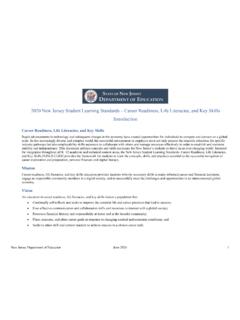Transcription of Life expectancy at birth - WHO
1 life expectancy at birth Rationale for use life expectancy at birth reflects the overall mortality level of a population. It summarizes the mortality pattern that prevails across all age groups - children and adolescents, adults and the elderly. Definition Average number of years that a newborn is expected to live if current mortality rates continue to apply. Associated terms A life table presents a set of tabulations that describe the probability of dying, the death rate and the number of survivors for each age or age group. Accordingly, life expectancy at birth is an output of a life table. Data sources Vital registration, census and surveys: Age-specific mortality rates required to compute life expectancy at birth .
2 Methods of estimation WHO has developed a model life table based on about 1800 life tables from vital registration judged to be of good quality. For countries with vital registration, the level of completeness of recorded mortality data in the population is assessed and mortality rates are adjusted accordingly. Where vital registration data for 2003 were available, these were used directly to construct the life table. For countries where the information system provided a time series of annual life tables, parameters from the life table were projected using a weighted regression model, giving more weight to recent years.
3 Projected values of the two life table parameters were then applied to the modified logit life table model, where the most recent national data provided an age pattern, to predict the full life table for 2003. In case of inadequate sources of age-specific mortality rates, the life table is derived from estimated under-5 mortality rates and adult mortality rates that are applied to a global standard (defined as the average of all the 1800 life tables) using a modified logit model. Disaggregation By sex, location (urban/rural, major regions/provinces). References - Modified logit life table system: principles, empirical validation and application Murray CJL, et al.
4 Modified logit life table system: principles, empirical validation and application. Population Studies 2003, 57(2):1-18. - The World Health Report 2006: working together for health. Geneva, World Health Organization, 2006. ( ). 1 . Database - WHO Mortality Database: Civil registration data ( ). Comments The lack of complete and reliable mortality data, especially for low income countries and particularly on mortality among adults and the elderly, necessitates the application of modelling (based on data from other populations) to estimate life expectancy . 2 . Healthy life expectancy (HALE). Rationale for use Substantial resources are devoted to reducing the incidence, duration and severity of major diseases that cause morbidity but not mortality and to reducing their impact on people's lives.
5 It is important to capture both fatal and non-fatal health outcomes in a summary measure of average levels of population health. Healthy life expectancy (HALE) at birth adds up expectation of life for different health states, adjusted for severity distribution making it sensitive to changes over time or differences between countries in the severity distribution of health states. Definition Average number of years that a person can expect to live in "full health" by taking into account years lived in less than full health due to disease and/or injury. Data sources Death registration data reported annually to WHO: Mortality data for calculation of life tables.
6 For countries without such data, available survey and census sources of information on child and adult mortality are analysed and used to estimate life tables. WHO Global Burden of Disease (GBD) study, WHO Multi-Country Survey Study (MCSS) and World Health Survey (WHS). Estimation of prevalence data. The GBD study draws on a wide range of data sources to develop internally consistent estimates for the incidence, prevalence, duration and years lived with disability for 135 major causes. The World Health Survey, carried out by WHO in more than 70 countries, uses anchoring vignettes to maximize comparability of self-report capacities for a set of core health domains.
7 It also includes a health state valuation module for assessing the severity of reported health states. Methods of estimation Since comparable health state prevalence data are not available for all countries, a four-stage strategy is used: Data from the WHOGBD study are used to estimate severity-adjusted prevalence by age and sex for all countries. Data from the WHOMCSS and WHS are used to make independent estimates of severity- adjusted prevalence by age and sex for survey countries. Prevalence for all countries is calculated based on GBD, MCSS and WHS estimates. life tables constructed by WHO are used with Sullivan's method to compute HALE for countries.
8 Disaggregation By age and sex. References 3 . - The world health report 2004 - changing history World Health Report 2004: Changing History. Geneva, World Health Organization, 2004. ( ). - Health systems performance assessment: debates, methods and empiricism. Mathers CD, et al. Methods for Measuring Healthy life expectancy . In: Murray CJL, Evans D, eds. Health systems performance assessment: debates, methods and empiricism. Geneva, World Health Organization, 2003. Database - Burden of Disease: ( ). Statistical measures relating to the burden of disease. Includes: Healthy life expectancy (HALE);. life expectancy ; Discussion Papers.
9 Also, this is where to find manuals, resources and software for carrying out national burden of disease studies. Comments The first challenge is lack of reliable data on mortality and morbidity, especially from low income countries. Other issues include lack of comparability of self-reported data from health interviews and the measurement of health-state preferences for such self-reporting. 4 . Probability of dying (per 1 000) between ages 15 and 60 years (adult mortality rate). Rationale for use Disease burden from non-communicable diseases among adults - the most economically productive age span - is rapidly increasing in developing countries due to ageing and health transitions.
10 Therefore, the level of adult mortality is becoming an important indicator for the comprehensive assessment of the mortality pattern in a population. Definition Probability that a 15 year old person will die before reachin g his/her 60th birthday. Associated terms The probability of dying between the ages of 15 and 60 years (per 1 000 population) per year among a hypothetical cohort of 100 000 people that would experience the age-specific mortality rate of the reporting year. life table (see life expectancy at birth ). Data sources Civil or sample registration: Mortality by age and sex are used to calculate age specific rates.














